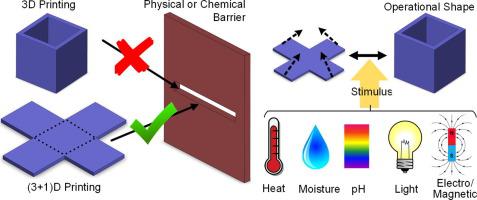当前位置:
X-MOL 学术
›
Mater. Today
›
论文详情
Our official English website, www.x-mol.net, welcomes your
feedback! (Note: you will need to create a separate account there.)
Smart polymers and nanocomposites for 3D and 4D printing
Materials Today ( IF 21.1 ) Pub Date : 2020-11-01 , DOI: 10.1016/j.mattod.2020.06.001 Mojtaba Falahati , Parvaneh Ahmadvand , Shahriar Safaee , Yu-Chung Chang , Zhaoyuan Lyu , Roland Chen , Lei Li , Yuehe Lin
Materials Today ( IF 21.1 ) Pub Date : 2020-11-01 , DOI: 10.1016/j.mattod.2020.06.001 Mojtaba Falahati , Parvaneh Ahmadvand , Shahriar Safaee , Yu-Chung Chang , Zhaoyuan Lyu , Roland Chen , Lei Li , Yuehe Lin

|
Abstract Smart materials, also known as intelligent materials, which are responsive to the external stimuli including heat, moisture, stress, pH, and magnetic fields, have found extensive applications in sensors, actuators, soft robots, medical devices and artificial muscles. Using three-dimensional (3D) printing techniques for fabrication of smart devices allows for complex designs and well-controlled manufacturing processes. 4D printing is attributed to the 3D printing of smart materials that can be significantly transformed over time. Herein the smart materials including hydrogels and polymeric nanocomposites used in 4D printing were reviewed and the fundamental mechanisms responsible for the functionalities were discussed in detail. In this report, 4D printing of smart systems and their applications in sensors, actuators and biomedical devices were reviewed to provide a deeper understanding of the current development and the future outlook.
中文翻译:

用于 3D 和 4D 打印的智能聚合物和纳米复合材料
摘要 智能材料,也称为智能材料,对外部刺激包括热、湿气、压力、pH 值和磁场做出响应,在传感器、执行器、软机器人、医疗设备和人造肌肉中得到了广泛的应用。使用三维 (3D) 打印技术制造智能设备可以实现复杂的设计和良好控制的制造过程。4D 打印归因于智能材料的 3D 打印,可以随着时间的推移发生显着变化。本文回顾了包括用于 4D 打印的水凝胶和聚合物纳米复合材料在内的智能材料,并详细讨论了负责这些功能的基本机制。在本报告中,智能系统的 4D 打印及其在传感器中的应用,
更新日期:2020-11-01
中文翻译:

用于 3D 和 4D 打印的智能聚合物和纳米复合材料
摘要 智能材料,也称为智能材料,对外部刺激包括热、湿气、压力、pH 值和磁场做出响应,在传感器、执行器、软机器人、医疗设备和人造肌肉中得到了广泛的应用。使用三维 (3D) 打印技术制造智能设备可以实现复杂的设计和良好控制的制造过程。4D 打印归因于智能材料的 3D 打印,可以随着时间的推移发生显着变化。本文回顾了包括用于 4D 打印的水凝胶和聚合物纳米复合材料在内的智能材料,并详细讨论了负责这些功能的基本机制。在本报告中,智能系统的 4D 打印及其在传感器中的应用,











































 京公网安备 11010802027423号
京公网安备 11010802027423号